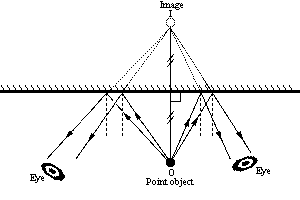| ERHS PHYSICS
Chapter 18.1 Notes: LIGHT |
|||
| Plane Mirrors:
Definitions and Concepts: A plane mirror is a planar reflecting surface, on which specular (regular) reflection is observed. A virtual image is formed by a plane mirror. The rays reflecting from the mirror appear to have originated from the location of the virtual image. On a diagram, a virtual image is usually depicted by a broken (dotted) arrow. A real image (formed by other kinds of optical devices) can be focused on a screen, whereas a virtual image can not. Real images are typically formed by curved mirrors.. On a diagram, a real image is usually depicted by a solid arrow. In any optical system there are four important image characteristics which need to be considered:
The image in a plane mirror is located as far behind the mirror as the object forming it is in front of the mirror. It is the same size as the object. (magnification = +1) magnification (m) = height of image /height of object = Hi / Ho = - di / do where di is the distance from the image to the mirror, and do is the distance from the object to the mirror. The image formed in a plane mirror is erect but laterally inverted. (Lateral inversion is also referred to as "left-right reversal, or "left-right inversion" ) Ray diagrams:
A solid line on a ray diagram is used to illustrate the path of a light ray. Arrows are used on the solid lines to show the direction of propagation of light. By convention, incident rays are usually depicted on a ray diagram as travelling from left to right. A dotted line is used as a construction line. Light rays do not travel along those dotted lines. Lenses and mirrors are shown in profile on ray diagrams. Interactive simulation of ray diagrams Ray tracing for mirrors: 1.An incident ray that is parallel to the principal axis is reflected such that it passes through the focus (or appears to have originated at the focus). Sign conventions: 1.The focal length (f) is positive for converging mirrors and lenses, and negative for diverging ones.
|
|||
